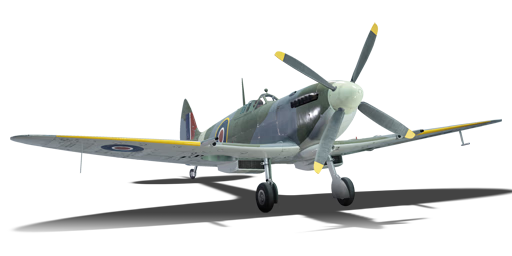



By March 1943, a new version of the Merlin engine had been developed. Designated the Merlin 66, it was even more powerful than the preceding 61 and 63 versions, was tuned for low-altitude operation, and featured a new injection-based carburettor instead of the float carburettor of previous models, completely resolving the fuel-flow issues during zero-G manoeuvres and inverted flight. Spitfire F Mk IXs equipped with this new engine were designated LF (low-altitude fighter) Mk IX (also commonly referred to as the Spitfire Mk IXb). Production of the improved type completely replaced those equipped with older engines by late 1943, and the LF became the most produced variant of the Mk IX, with over 4,000 aircraft built.
Introduced in Update 1.35, the Spitfire LF Mk IX is very much a short range, point interceptor fighter and the stand-out fighter in the mid Spitfire line-up. It features an exceptional rate of climb, whilst still retaining the manoeuvrability of its early lineage. The LF Mk IX is considered by many to be the perfect Spitfire due to its balanced all-round performance and impressive statistics. The last of the Merlin-engined Spitfires before progressing on to the Griffon-powered variants, it has the perfect balance of turning performance (second only to its Japanese counterparts) as well as its "Boom and Zoom" capability that becomes more possible with later model Spitfires. However, the LF Mk IX also reverts to the rather outmoded twin cannon and twin machine gun layout of its predecessors, which can result in rather meagre damage output compared to its contemporaries and opponents.
flaps
flaps
flaps
brake
| Belt | Belt filling | Armor penetration (mm) at a distance: | |||||
|---|---|---|---|---|---|---|---|
| 10 m | 100 m | 500 m | 1000 m | 1500 m | 2000 m | ||
| HEI/SAP-I/T | 22 | 20 | 14 | 9 | 6 | 4 | |
| AP-T/HEI/SAP-I | 37 | 35 | 25 | 16 | 10 | 7 | |
| T/HEI/SAP-I/HEI/SAP-I | 22 | 20 | 14 | 9 | 6 | 4 | |
| AP-T/T/HEI | 37 | 35 | 25 | 16 | 10 | 7 | |
| AP-T/SAP-I/HEI/AP-T | 37 | 35 | 25 | 16 | 10 | 7 | |
| HEI/HEI/SAP-I | 22 | 20 | 14 | 9 | 6 | 4 | |
| Belt | Belt filling | Armor penetration (mm) at a distance: | |||||
|---|---|---|---|---|---|---|---|
| 10 m | 100 m | 500 m | 1000 m | 1500 m | 2000 m | ||
| T/Ball/Ball/I/AP-I | 26 | 24 | 18 | 12 | 8 | 5 | |
| AP-I/AP-I/AP-I/T/I | 26 | 24 | 18 | 12 | 8 | 5 | |
| T/AP/AP/AP-I/AP-I/I | 30 | 27 | 20 | 13 | 9 | 6 | |
| T/T/T/T/T/AP-I | 26 | 24 | 18 | 12 | 8 | 5 | |
| AP-I/AP-I/AP-I/I/I | 26 | 24 | 18 | 12 | 8 | 5 | |












Flight performance | |
|---|---|
Survivability |
|---|
Weaponry | |
|---|---|